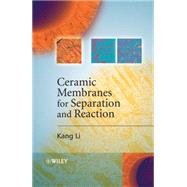
Kang Li is Professor of Chemical Engineering at Imperial College London. His present research interests are in the preparation and characterisation of polymeric and inorganic hollow fibre membranes, fluid separations using membranes, and membrane reactors for energy application and CO2 capture. Kang Li currently leads a research group at Imperial of 2 MSc students, 8 PhD students and 3 post-doctorial research fellows. He has published over 180 research papers in international referred journals, holds five patents, and is the author of a book in the area of ceramic membranes - Ceramic Membranes for Separation and Reaction, John Wiley, 2007 -.
| Ceramic Membranes and Membrane Processes | |
| Introduction | |
| Membrane Processes | |
| Gas separation | |
| Pervaporation | |
| Reverse osmosis and nanofiltration | |
| Ultrafiltration and microfiltration | |
| Dialysis | |
| Electrodialysis | |
| Membrane contactor | |
| Membrane reactors | |
| References | |
| Preparation of Ceramic Membranes | |
| Introduction | |
| Slip casting | |
| Tape casting | |
| Pressing | |
| Extrusion | |
| Sol-gel process | |
| Dip-coating | |
| Chemical vapour deposition (CVD) | |
| Preparation of hollow fibre ceramic membranes | |
| Preparation of spinning suspension | |
| Spinning of ceramic hollow fibre precursors | |
| Sintering | |
| Example 1: Preparation of porous Al 2 O 3 hollow fibre membranes | |
| Example 2: Preparation of TiO 2 /Al 2 O 3 composite hollow fibre membranes | |
| Example 3: Preparation of dense perovskite hollow fibre membranes | |
| Surface forces | |
| References | |
| Characterisation of Ceramic Membranes | |
| Introduction | |
| Morphology of membrane surfaces and cross sections | |
| Porous ceramic membranes | |
| Gas adsorption/desorption isotherms | |
| Permporometry | |
| Mercury porosimetry | |
| Thermoporometry | |
| Liquid displacement techniques | |
| Bubble point method | |
| Liquid displacement method | |
| Permeation method | |
| Liquid permeation | |
| Gas permeation | |
| Measurements of solute rejection | |
| Dense ceramic membranes | |
| Leakage test | |
| Permeation measurements | |
| XRD | |
| Mechanical strength | |
| Notation | |
| References | |
| Transport and Separation of Gases in Porous Ceramic Membranes | |
| Introduction | |
| Performance indicators of gas separation membranes | |
| Ceramic membranes for gas separation | |
| Transport Mechanisms | |
| Knudsen and slip flow | |
| Viscous flow | |
| Surface flow | |
| Capillary condensation | |
| Configurational or micropore diffusion | |
| Simultaneous occurrence of different mechanism | |
| Modification of porous ceramic membranes for gas separation | |
| Resistance model for gas transport in composite membranes | |
| Effect of support layers | |
| Effect of non-zeolitic pores | |
| Effect of coating | |
| System design | |
| Operating Schemes | |
| Perfect mixing | |
| Cross flow | |
| Parallel plug flow | |
| Design equations for membrane processes in gas separation | |
| Perfect mixing | |
| Cross flow | |
| Cocurrent flow | |
| Countercurrent flow | |
| Notation | |
| References | |
| Ceramic Hollow Fibre Membrane Contactors for Treatment of Gases/Vapours | |
| Introduction | |
| General review | |
| Operating modes and mass transfer coefficients | |
| Nonwetted mode | |
| Wetted mode | |
| Mass transfer coefficients determined from experiments | |
| Mass transfer in hollow fibre contactors | |
| Mass transfer in hollow fibre lumen | |
| Mass transfer across membrane | |
| Mass transfer in shell side of a contactor | |
| Nonwetted, wetted, and partially wetted conditions in a hollow fibre contactor | |
| Effect of chemical reaction | |
| Instantaneous reaction | |
| Fast reaction | |
| Design equ | |
| Table of Contents provided by Publisher. All Rights Reserved. |
The New copy of this book will include any supplemental materials advertised. Please check the title of the book to determine if it should include any access cards, study guides, lab manuals, CDs, etc.
The Used, Rental and eBook copies of this book are not guaranteed to include any supplemental materials. Typically, only the book itself is included. This is true even if the title states it includes any access cards, study guides, lab manuals, CDs, etc.